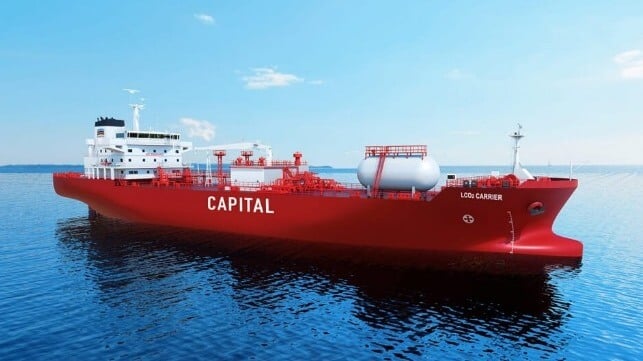Capital Gas Advances LCO2 Carrier Operations Adding Onboard Carbon Capture

Greece’s Capital Gas has already advanced the emerging LCO2 industry upsizing the carriers and now they plan to further improve the vessels' performance by adding onboard carbon capture systems. Last year, Capital Maritime became the first large shipowner to order LCO2 carriers and today at Posidonia they signed a letter of intent to install a pioneering carbon capture and storage system.
Capital will be working with Greece’s ERMA First, a company focusing on sustainable maritime solutions, and Babcock LGE, a provider of cargo handling and fuel gas supply systems. According to the companies, under normal conditions, carbon capture systems are expected to cut vessel CO2 emissions by 15 to 20 percent, but with the ERMA technology they project that they will achieve a CO2 capture rate exceeding 70 percent.
“The addition of onboard carbon capture to these first-of-a-kind vessels, in conjunction with our industry-defining ecoCO2 system, is a significant step towards achieving the shipping industry’s emissions reduction targets,” said Neale Campbell, Managing Director, Babcock LGE. “The ecoCO2 design concept for handling both CO2 and LPG cargoes provides a flexible solution that can easily be upgraded to incorporate carbon capture and storage requirements.”
The ERMA First Carbon Fit system uses amine absorption technology based on a proprietary amine solvent to absorb CO2 from flue gases. The resultant mix is then heated to produce a chemical reaction that reverses the absorption, separating the CO2 from the solvent. The released CO2 will then be liquefied using Babcock LGE’s ecoCO2 system and stored on board the ship in pressurized low-temperature storage for subsequent offloading. The solvent can also be reused once the CO2 is released.
Both Lloyd’s Register and DNV have reviewed the design concepts for the CO2 capture system. EMRA First highlights that it holds Approval in Principle (AiP) from both LR and DNV for its onboard system.
Capital announced plans in 2023 to build the first medium-size LCO2 carriers and the first for the anticipated market to transport CO2 in large quantities stored under pressure from emitters to facilities for sequestration or further use. Capital, which currently operates 20 LNG carriers and eight LPG vessels looks to build a new market for LCO2 transportation.

that matters most
Get the latest maritime news delivered to your inbox daily.
The vessels that will be built by Hyundai Mipo in South Korea will have a capacity of 22,000 m3 which compares with the Northern Lights vessels which will carry 7,500 m3. They highlighted when the vessels were ordered that will be equipped with IMO Type C storage tanks. In addition to the lighter scantling that maintains the structure, they highlighted plans for innovative materials that will help to increase the capacity of the vessels. The vessels will each be approximately 525 feet in length.
Hyundai reported the order in July 2023 saying in a stock exchange filing that it would build two vessels valued at $141 million. Capital reports the order has been increased to four vessels due for delivery in 2025 and 2026. Capital is also working with HD Hyundai Heavy Industries on designs for a 40,000 m3 LCO2 carrier.
